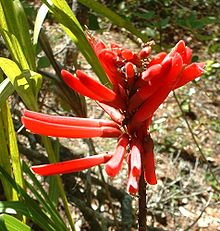- Erythrina herbacea
-
"Coral Bean" redirects here. For widespread Purple Coral Tree, see Erythrina fusca.
Erythrina herbacea 
Flowers Scientific classification Kingdom: Plantae (unranked): Angiosperms (unranked): Eudicots (unranked): Rosids Order: Fabales Family: Fabaceae Genus: Erythrina Species: E. herbacea Binomial name Erythrina herbacea
L.Synonyms Erythrina herbacea, commonly known as the Coral Bean, Cherokee Bean, Red Cardinal or Cardinal Spear, is a flowering shrub or small tree found throughout the southeastern United States and northeastern Mexico;[1] it has also been reported from parts of Central America and, as an introduced species, from Pakistan. Various other systematic names have been used for this plant in the past, including Erythrina arborea, Erythrina hederifolia, Erythrina humilis, Erythrina rubicunda, Corallodendron herbaceum and Xyphanthus hederifolius.
Contents
Description
Coral Bean grows as a low shrub or small tree, reaching around 5 m (16 ft) in height in areas that do not kill it back by freezing;[2] elsewhere it may only reach 1.2 m (3.9 ft). Stems are covered in curved spines.[3] The leaves are yellowish-green, 15–20 cm (5.9–7.9 in) long and 6 cm (2.4 in) wide. The leaves are divided into three 2.5–8 cm (0.98–3.1 in) arrowhead-shaped leaflets.[2] The bark is smooth and light gray.[4] The tubular flowers are bright red and grow in long spikes,[5] each flower being 4–6.5 cm (1.6–2.6 in) long;[2] the tree blooms from April to July.[3] They are followed by 5–10 cm (2.0–3.9 in) pods containing bright red seeds, from which the tree gets its name.[2] Toxic alkaloids, including erysopine, erysothiopine, erysothiovine, erysovine, erythrinine, erythroresin, coralin, erythric acid, and hypaphorine,[6] are found throughout the plant. These cause paralysis upon ingestion, much like curare.[7]
Coral Bean grows best in sandy soils and has moderate salt tolerance. It can be found in open woods, forest clearings, hammocks, and disturbed areas.[8]
Uses
E. herbacea can be readily grown in gardens within its natural range. Although its use in gardens is not particularly common, it is popular among those who do grow it as a source of early season color, for its hardiness (USDA Zones 7-10), and because it attracts hummingbirds.[9]
Native American people had many medicinal uses for this plant, varying between nations and localities. Creek women used an infusion of the root for bowel pain; the Choctaw used a decoction of the leaves as a general tonic; the Seminole used an extract of the roots for digestive problems, and extracts of the seeds, or of the inner bark, as an external rub for rheumatic disorders.[10]
In Mexico, the seeds are used as a rat poison, while a fish poison is made from the bark and leaves.[7]
References
- ^ a b "Erythrina herbacea L.". Germplasm Resources Information Network. United States Department of Agriculture. 1998-09-07. http://www.ars-grin.gov/cgi-bin/npgs/html/taxon.pl?15748. Retrieved 2009-10-24.
- ^ a b c d Nelson, Gil (1994). The Trees of Florida: a Reference and Field Guide. Pineapple Press Inc.. p. 213. ISBN 9781561640553. http://books.google.com/books?id=Wzmo7cHvhZkC.
- ^ a b Duncan, Wilbur H.; Marion B. Duncan (2005). Wildflowers of the Eastern United States. University of Georgia Press. p. 39. ISBN 9780820327471. http://books.google.com/books?id=zG1v3bdd1c0C.
- ^ "Coral Bean Erythrina herbacea". FieldGuides. eNature. http://www.enature.com/fieldguides/detail.asp?recnum=TS0258. Retrieved 2009-10-24.
- ^ "Erythrina herbacea L.". Native Plant Information Network. Lady Bird Johnson Wildflower Center. http://www.wildflower.org/plants/result.php?id_plant=ERHE4. Retrieved 2009-10-24.
- ^ Austin, Daniel F. (2004). Florida Ethnobotany. CRC Press. p. 291. ISBN 9780849323324. http://books.google.com/books?id=eS7lX_rC3GEC.
- ^ a b Tull, Delena (1999). Edible and Useful Plants of Texas and the Southwest: A Practical Guide. University of Texas Press. p. 254. ISBN 9780292781641. http://books.google.com/books?id=pnnHgcasN-cC.
- ^ "Coralbean (Erythrina herbacea)". Florida Forest Plants. Florida 4-H Forest Ecology. http://www.sfrc.ufl.edu/4h/Coralbean/coralbea.htm. Retrieved 2009-10-24.
- ^ Bird Gardens: Welcoming Wild Birds to Your Yard. Brooklyn Botanic Garden. 1998. p. 56. ISBN 9781889538082. http://books.google.com/books?id=BwSDi2tMIPEC.
- ^ Moerman, Daniel E. (2009). Native American Medicinal Plants: An Ethnobotanical Dictionary. Timber Press. p. 227. ISBN 9780881924534. http://books.google.com/books?id=H8Msgmq5XbcC.
- Atlas of Florida Vascular Plants: Erythrina herbacea
- Plants data base entry: Erythrina herbacea
- Alden, P., et al. (1988). National Audubon Society field guide to Florida. New York: Knopf.
External links
- "Erythrina herbacea" (PDF). Digital Representations of Tree Species Range Maps from "Atlas of United States Trees" by Elbert L. Little, Jr. (and other publications). United States Geological Survey. http://esp.cr.usgs.gov/data/atlas/little/erytherb.pdf.
Categories:- Erythrina
- Plants described in 1753
- Trees of Alabama
- Trees of Arkansas
- Trees of Florida
- Trees of Georgia (U.S. state)
- Trees of Louisiana
- Trees of Mississippi
- Trees of North Carolina
- Trees of South Carolina
- Trees of Tamaulipas
- Trees of Texas
Wikimedia Foundation. 2010.
